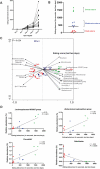Impact of early-life feeding on local intestinal microbiota and digestive system development in piglets
- PMID: 33603087
- PMCID: PMC7892833
- DOI: 10.1038/s41598-021-83756-2
Impact of early-life feeding on local intestinal microbiota and digestive system development in piglets
Abstract
Early-life gut microbial colonisation is known to influence host physiology and development, shaping its phenotype. The developing gastro-intestinal tract of neonatal piglets provides a "window of opportunity" for programming their intestinal microbiota composition and corresponding intestinal development. Here, we investigated the impact of early feeding on jejunum and colon microbiota composition, and intestinal maturation in suckling piglets. From two days of age, early-fed (EF; n = 6 litters) piglets had access to solid feed containing a mixture of fibres till weaning (day29) in addition to sow's milk, whereas the control (CON; n = 6 litters) piglets exclusively fed on sow's milk. Early feeding elicited a significant impact on the colon microbiota, whereas no such effect was seen in the jejunal and ileal microbiota. Quantified eating behavioural scores could significantly explain the variation in microbiota composition of EF piglets and support their classification into good, moderate, and bad eaters. Members of the Lachnospiraceae family, and the genera Eubacterium, Prevotella, and Ruminococcus were quantitatively associated with eating scores. EF piglets were found to have a decreased pH in caecum and colon, which coincided with increased short-chain fatty acid (SCFA) concentrations. Moreover, they also had increased weights and lengths of several intestinal tract segments, as well as a decreased villus-crypt ratio in jejunal mucosa and an increased abundance of proliferative cells in colon mucosa. The approaches in this study indicate that early feeding of a mixed-fibre (pre-weaning) diet changes the microbiota composition, pH, and fermentation products in the distal gut of piglets, while it also alters both macroscopic and microscopic intestinal measurements. These results exemplify the potential of early feeding to modulate intestinal development in young piglets.
Conflict of interest statement
The authors declare no competing interests.
Figures





References
-
- Gundlach H. Brutfürsorge, Brutpflege, Verhaltensontogenese und Tagesperiodik beim Europäischen Wildschwein (Sus scrofa L.)1. Z. Tierpsychol. 1968;25:955–995. - PubMed
-
- Meynhardt H. Schwarzwild-Report: Vier Jahre unter Wildschweinen. Leipzig Radebeul: Neumann Verlag; 1980.
-
- Petersen V. The development of feeding and investigatory behaviour in free-ranging domestic pigs during their first 18 weeks of life. Appl. Anim. Behav. Sci. 1994;42:87–98. doi: 10.1016/0168-1591(94)90149-X. - DOI
-
- Newberry RC, Wood-Gush DGM. The suckling behaviour of domestic pigs in a semi-natural environment. Behaviour. 1985;95:11–25. doi: 10.1163/156853985X00028. - DOI
-
- Jensen P, Stangel G. Behaviour of piglets during weaning in a seminatural enclosure. Appl. Anim. Behav. Sci. 1992;33:227–238. doi: 10.1016/S0168-1591(05)80010-3. - DOI
Publication types
MeSH terms
Substances
LinkOut - more resources
Full Text Sources
Other Literature Sources
Research Materials

